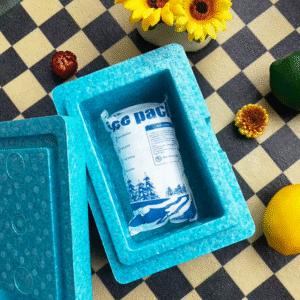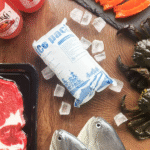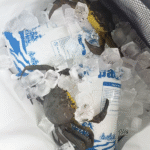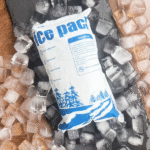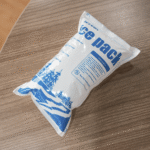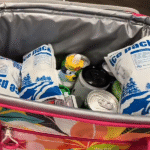Como usar gelo seco em refrigeradores para envio seguro e eficiente
Shipping temperature-sensitive items, such as perishable food, vacinas, e amostras de biotecnologia, requer soluções de refrigeração confiáveis. Using coolers with dry ice packs is an effective way to keep items frozen for extended periods without the mess of melting ice. Neste guia, we will cover the steps on how to use dry ice in coolers com segurança, melhores práticas, and the benefits it offers in modern cold chain logistics.
Esteja você enviando frutos do mar, produtos farmacêuticos, ou outros bens perecíveis, dry ice is one of the most efficient ways to maintain low temperatures. A -78,5 ° C. (-109.3°F), dry ice is significantly colder than regular ice, making it ideal for shipments that require extended freezing. This guide will walk you through the process of using dry ice in coolers for safe and efficient shipping.
-
How dry ice works in coolers
-
Best practices for safe dry ice handling
-
How to pack coolers efficiently with dry ice
-
Comparing dry ice and regular ice for different shipping needs
-
Key regulations and compliance for shipping with dry ice
How Does Dry Ice Work in Coolers?
Gelo seco é dióxido de carbono sólido (Co₂) and sublimates directly into gas at a temperature of -78.5°C (-109.3°F). Ao contrário do gelo regular, que derrete na água, dry ice does not leave any residue, tornando-o ideal para remessas de longa duração. The cooling effect occurs as dry ice absorbs heat from the surrounding environment, keeping items inside the cooler frozen for much longer than regular ice.
Key Benefits of Using Dry Ice in Coolers
-
Duração estendida de resfriamento: Dry ice keeps contents frozen for longer periods compared to regular ice, which is crucial for long-distance shipments.
-
Sem resíduos de água: Como o gelo seco sublima em gás, there’s no risk of water damage to your goods, which is especially important for sensitive items.
-
Efficient Space Utilization: Dry ice takes up less space than regular ice, allowing you to pack more items without sacrificing cooling efficiency.
-
Better for Sensitive Items: Dry ice is preferred for shipping pharmaceuticals, vacinas, e amostras de biotecnologia, as it maintains a constant low temperature.
Como embalar um refrigerador com gelo seco: Um guia passo a passo
Etapa 1: Select the Right Cooler
Choose a cooler that is well-insulated and can accommodate both your items and the dry ice. A high-quality cooler helps retain cold for longer and is essential for ensuring the dry ice lasts for the necessary duration.
-
Qualidade de isolamento: Select coolers that feature thick insulation to prevent temperature fluctuations.
-
Ventilação: Gelo seco sublima em gás co₂, so ensure your cooler has a vent or that you leave a small gap to allow the gas to escape.
Etapa 2: Manuseie o gelo seco com segurança
Always wear insulated gloves or use tongs to handle dry ice. Its extreme cold can cause frostbite if touched directly.
Etapa 3: Pack the Cooler Efficiently
Layer the dry ice at the bottom of the cooler, as cold air naturally sinks. Place insulating materials between the dry ice and your goods to prevent direct contact. This helps avoid freezing the contents or damaging them.
-
Camadas: Para bens perecíveis, layer insulation like cardboard or towels to protect them from direct contact with the dry ice.
Etapa 4: Seal the Cooler Properly
Once the cooler is packed, ensure it is sealed tightly but not airtight. Dry ice needs a way to release CO₂ gas to avoid pressure buildup, which could lead to dangerous situations.
Etapa 5: Monitore a temperatura
Para itens sensíveis, it’s recommended to use temperature monitoring devices to track the conditions inside the cooler during transit.
Etapa 6: Descarte o gelo seco com segurança
Deixe o gelo seco sublimar em uma área bem ventilada. Nunca descarte-o em um recipiente lacrado, as the buildup of gas can cause the container to explode.
Gelo seco vs.. Gelo regular: Qual você deve usar?
| Recurso | Gelo Seco | Gelo regular |
|---|---|---|
| Temperatura | -109.3°F (-78.5°C) | 32°F (0°C) |
| Duração do resfriamento | 2-14 dias | 1-10 dias |
| Resíduo | Sublimados em gás, Sem líquido | Derrete na água |
| Uso ideal | Long-term freezing, off-grid use | Short-term chilling, piqueniques |
| Peso | Lighter due to higher cooling power | Heavier for same cooling power |
Melhores práticas para usar gelo seco em refrigeradores
-
Use a quantidade certa: Para remessas longas, calculate the amount of dry ice based on the temperature and duration of the journey. Tipicamente, 5-10 pounds of dry ice are needed per 24 horas.
-
Garanta ventilação adequada: Always make sure that the cooler has proper ventilation to release CO₂ gas. Failure to do so can cause dangerous pressure buildup.
-
Layer Correctly: Place dry ice at the bottom for frozen items and use insulating layers between the dry ice and the goods to protect them.
Regulations for Shipping with Dry Ice
Ao enviar com gelo seco, there are specific regulations to follow, especially when shipping via air.
-
Rotulagem UN1845: Dry ice shipments must be labeled as “UN1845 Dry Ice” ou “Dióxido de carbono, solid.” Ensure that the net weight of the dry ice is clearly marked on the package.
-
Regulamentos da IATA: Se envio por ar, certain restrictions apply, incluindo limites de peso (por exemplo, 2.5 kg per passenger on consumer airlines).
-
Ventilation and Packaging: Use proper packaging materials that allow the CO₂ gas to escape, such as corrugated boxes with ventilation holes.
2025 Tendências na logística da cadeia fria
À medida que nos mudamos para 2025, there are several trends shaping the cold chain industry, incluindo:
-
Materiais ecológicos: With increasing demand for sustainability, companies are moving towards recyclable materials and reducing single-use plastics in packaging.
-
Monitoramento de temperatura inteligente: Real-time monitoring with Bluetooth-enabled devices is becoming more affordable and widely adopted, ensuring accurate tracking of shipments.
-
Ready-to-Use Kits: Preassembled cold chain solutions are gaining popularity, saving time and minimizing errors during packing.
Perguntas frequentes
Q1: Quanto gelo seco eu preciso para o meu refrigerador?
A good rule of thumb is to use 5-10 libras de gelo seco por 24 horas de envio. Adjust based on the cooler size, duração, e condições de temperatura externa.
Q2: Posso usar gelo seco para enviar comida?
Sim, dry ice is ideal for shipping perishable foods, especially those that need to stay frozen, como frutos do mar, carnes, e sorvete.
Q3: How do I handle and dispose of dry ice safely?
Sempre use luvas isoladas ao manusear gelo seco. Dispose of it by allowing it to sublimate in a well-ventilated area, ensuring it has no contact with airtight containers.
Conclusão
Dry ice is a reliable and effective solution for keeping items frozen during long shipments, seja para comida, produtos farmacêuticos, ou amostras biotecnológicas. By following proper packing techniques, ensuring correct ventilation, e aderindo aos regulamentos de transporte, you can safely and efficiently use dry ice for cold chain logistics. Stay informed about the latest trends and best practices to optimize your cold chain operations.






